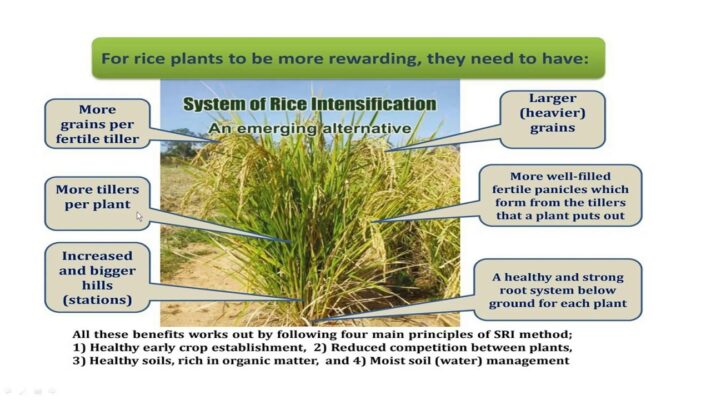- Home
- Prelims
- Mains
- Current Affairs
- Study Materials
- Test Series
System of Rice Intensification (SRI) method of sowing paddy saves 15-20% water, gives better yield
The System of Rice Intensification (SRI) was established in Madagascar in the 1980s, and numerous nations throughout the world have used it since then, including India. It claims to conserve 15 to 20% of ground water and enhance rice yield, which is now stagnant. It produces the same or more than conventional rice production while using less water, seed, and pesticides. The overall result is a significant reduction in investments in external inputs.
Requirements
-
Ploughing is done first to prepare the field.
-
Before transplanting, it should be laser leveled to ensure adequate water management and efficiency for a healthy crop stand.
-
Then irrigation is provided to the field, which is less than that of a well-irrigated field but not as much as traditional techniques.
-
Then, with the use of a rope meter, 10-12 day old nursery plants (young paddy plants) are transplanted in lines with soil particles surrounding the roots with minimal disruption to the roots.
-
The goal of constructing lines is to create a favorable environment for rice plant growth and development by spacing them out.
-
-
To prevent a time gap between uprooting and planting, which should not be more than 30-40 minutes.
-
So that the roots do not dry out, seedlings or nurseries should be positioned near to the main field.
-
-
Unlike DSR, which is only ideal for medium to heavy textured soils, SRI is good for all types of soil, even less fertile soil, where the number of seedlings can be doubled.
-
In the SRI approach, just 2kg seed is needed to produce a nursery for one acre, compared to 5kg seed in the old method.
|
How is it different from DSR technique ?
|
SRI technique does not require constant flooding after nursery transplantation
-
Fields are kept under flood-like conditions in traditional sowing from the day of transplanting until the crop turns 35-40 days. Then, until a few weeks before harvest, fields are filled every week.
-
SRI, on the other hand, does not require continual flooding but rather periodic watering.
-
The roots of the plants should not be deprived of oxygen due to floods.
-
Water is introduced to the field when the surface soil develops hairline cracks, and irrigation is administered to keep soil moisture near saturation at first.
-
-
The intervals between irrigations will vary depending on the field conditions.
-
During a study in—- Gurdaspur district fields where Pusa 1121 was planted, it was discovered that 50 lakh litres of groundwater were consumed, compared to 62 lakh litres for the same variety in a puddled technique field.
-
Weeds management in SRI
-
In DSR, where weeds are a major issue and weedicides are sprayed simultaneously at the time of sowing.
-
In SRI, which allows for greater weed growth due to alternate wetting and drying of fields, the weeds are incorporated into the soil by operating a cono-weeder between rows made at the time of sowing, which adds nutrients to the crop like green manures.
-
10-12 days after planting, first weeding is undertaken. Depending on the need, more weddings can be done at 10-15 day intervals till the crop reaches panicle stage.
-
Through a process of soil aeration, each weeding improves production.
-
It is recommended that weeding and irrigation be done at the same time for a smoother and simpler functioning of the cono-weeder.
Benefits
-
Increased water availability at the landscape level or for other consumption demands, since SRI management can cut irrigation water use by up to 50%.
-
Reduced agrochemical usage leads to improved soil and water quality.
-
Organic matter additions to soils and residues from bigger root systems result in an increase in soil carbon reservoirs.
-
Reduced methane emissions from rice paddies due to non-flooded rice paddy conditions; thus far, despite the need for additional study, no offsetting rise in nitrous oxide emissions has been seen.
-
Rice cultivar biodiversity can be increased if local types become more productive and hence more appealing to farmers to produce.

Limitations
-
Increased weed growth, if left unchecked, will result in a significant loss of yield.
-
If organic inputs in the soil structure are maintained, it can be sustainable.
-
In addition, scientists and farmers must undertake more research by performing experiments on small plots of land at first, and accurate study records must be kept.
-
In Telangana, a large area was brought under SRI to conduct a study, and the results are quite encouraging in terms of water saving, lower input costs, and improved plant growth, adding that to save water.
-
A large area was brought under SRI to conduct a study, and the results are quite encouraging in terms of water saving, lower input costs, and improved plant growth.
-









 Latest News
Latest News
 General Studies
General Studies